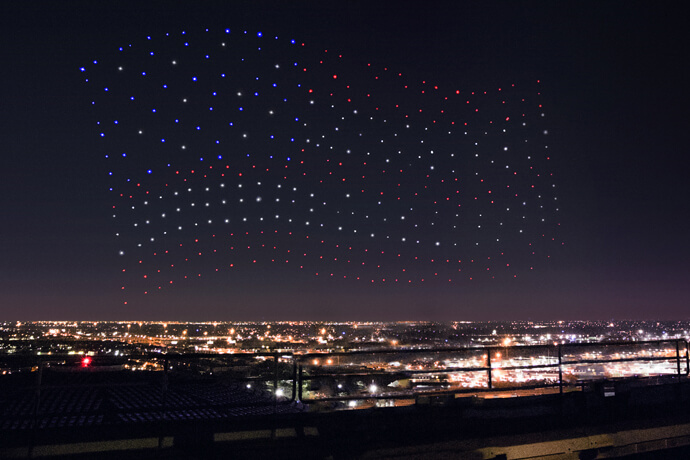By Gary Mortimer
6 February 2017
 I
I
ntel Shooting Star drones light up the sky in an American Flag formation during the Pepsi Zero Sugar Super Bowl LI Halftime Show. (Credit: Intel Corporation)
Well done to everyone at Ascending Technologies, the German drone manufacturer bought by Intel in January 2016.
They have demonstrated that they are world leaders when it comes to swarm flying. The software and animation interface on the Intel Shooting Star drone system allows a light show to be created in a matter of days or weeks depending on the animation complexity.
The 300 drones used at the Super Bowl flew a few days earlier; the cutaway point being when Lady Gaga jumped! The airframes had been flying for Disney during the holiday season. The technology is not for sale!
Proprietary algorithms automate the animation creation process by using a reference image, quickly calculating the number of drones needed, determining where drones should be placed, and formulating the fastest path to creating the image in the sky. The light show software also runs a complete fleet check before each flight and can select the most optimised drones for each flight based on battery life, GPS reception and more. The fleet size is dependent on the animation needed and can range from hundreds of Intel Shooting Star drones or even more in the future.
As someone that has been watching AscTec for years, it grates a little that this is being held up as in Intel achievement. But I’m sure the team at home in Germany are ok with it.
Intel was very smart buying into one of the oldest multirotor manufacturers.
Ascending Technologies started experimenting with sky choreography and quadrocopters in 2012 getting ready for the “Klangwolke” Festival in collaboration with Ars Electronica Futurelab.
Well done to everyone at Ascending Technologies, the German drone manufacturer bought by Intel in January 2016.
They have demonstrated that they are world leaders when it comes to swarm flying. The software and animation interface on the Intel Shooting Star drone system allows a light show to be created in a matter of days or weeks depending on the animation complexity.
The 300 drones used at the Super Bowl flew a few days earlier; the cutaway point being when Lady Gaga jumped! The airframes had been flying for Disney during the holiday season. The technology is not for sale!
Proprietary algorithms automate the animation creation process by using a reference image, quickly calculating the number of drones needed, determining where drones should be placed, and formulating the fastest path to creating the image in the sky. The light show software also runs a complete fleet check before each flight and can select the most optimised drones for each flight based on battery life, GPS reception and more. The fleet size is dependent on the animation needed and can range from hundreds of Intel Shooting Star drones or even more in the future.
As someone that has been watching AscTec for years, it grates a little that this is being held up as in Intel achievement. But I’m sure the team at home in Germany are ok with it.
Intel was very smart buying into one of the oldest multirotor manufacturers.
Ascending Technologies started experimenting with sky choreography and quadrocopters in 2012 getting ready for the “Klangwolke” Festival in collaboration with Ars Electronica Futurelab.
This lead to many other interesting formations around the world. A Kangaroo in Austraila caused wows.
My personal favourite was the Star Trek logo over central London. This occurred at the same time as the first test of two small civil UAS in restricted airspace at night in the USA. Something the FAA and other folks were keen to shout about. I thought the irony was delicious.
Here is how they got away with multiple aircraft one pilot and VO, from the FAA waiver granted for the performance.
Operation of Multiple sUAS Special Provisions.
sUAS operations with multiple sUA may be conducted, provided:
15. Prior to conducting operations under this Waiver, the remote PIC has a means to identify the boundaries of any structure so as to avoid collision with, or damage to property;
16. Communication between the remote PIC and VO must allow for the remote PIC to light the sUA and/or ground the sUA with sufficient time to yield right-of-way in accordance with § 107.37.
17. The remote PIC must ensure that an individual system failure does not interfere with the operation of other sUA or cause incidents, accidents, or loss of control involving other aircraft in the swarm;
18. Prior to conducting operations under this Waiver, the remote PIC must ensure that the cylindrical, two-layer geo-fence system and its associated flight control system, as described in the Waiver application, operate properly and are programmed for visual alerts if they contact any geo-fence boundary;
19. Prior to conducting operations under this Waiver, the remote PIC must ensure that the sUA sensors and their flight control systems operate properly; and
20. The weight of the sUA flown under this Waiver must not exceed .75 lbs and the ground speed of the sUA must not exceed 12 nautical miles per hour (14 miles per hour)
Read more:
No comments:
Post a Comment